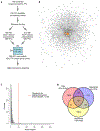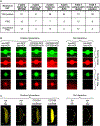A Comprehensive Drosophila melanogaster Transcription Factor Interactome
- PMID: 30995488
- PMCID: PMC6485956
- DOI: 10.1016/j.celrep.2019.03.071
A Comprehensive Drosophila melanogaster Transcription Factor Interactome
Abstract
Combinatorial interactions among transcription factors (TFs) play essential roles in generating gene expression specificity and diversity in metazoans. Using yeast 2-hybrid (Y2H) assays on nearly all sequence-specific Drosophila TFs, we identified 1,983 protein-protein interactions (PPIs), more than doubling the number of currently known PPIs among Drosophila TFs. For quality assessment, we validated a subset of our interactions using MITOMI and bimolecular fluorescence complementation assays. We combined our interactome with prior PPI data to generate an integrated Drosophila TF-TF binary interaction network. Our analysis of ChIP-seq data, integrating PPI and gene expression information, uncovered different modes by which interacting TFs are recruited to DNA. We further demonstrate the utility of our Drosophila interactome in shedding light on human TF-TF interactions. This study reveals how TFs interact to bind regulatory elements in vivo and serves as a resource of Drosophila TF-TF binary PPIs for understanding tissue-specific gene regulation.
Keywords: BiFC; ChIP-seq analysis; Drosophila melanogaster; MITOMI; in vivo bimolecular fluorescence complementation assay; protein-protein interactions; transcription factor-DNA interactions; transcription factors; yeast two-hybrid.
Copyright © 2019 The Authors. Published by Elsevier Inc. All rights reserved.
Conflict of interest statement
DECLARATION OF INTERESTS
M.L.B. is a co-inventor on patents on PBM technology.
Figures




Similar articles
-
Next-generation large-scale binary protein interaction network for Drosophila melanogaster.Nat Commun. 2023 Apr 15;14(1):2162. doi: 10.1038/s41467-023-37876-0. Nat Commun. 2023. PMID: 37061542 Free PMC article.
-
Curated collection of yeast transcription factor DNA binding specificity data reveals novel structural and gene regulatory insights.Genome Biol. 2011 Dec 21;12(12):R125. doi: 10.1186/gb-2011-12-12-r125. Genome Biol. 2011. PMID: 22189060 Free PMC article.
-
Widespread evidence of cooperative DNA binding by transcription factors in Drosophila development.Nucleic Acids Res. 2013 Sep;41(17):8237-52. doi: 10.1093/nar/gkt598. Epub 2013 Jul 11. Nucleic Acids Res. 2013. PMID: 23847101 Free PMC article.
-
A conserved role for transcription factor sumoylation in binding-site selection.Curr Genet. 2019 Dec;65(6):1307-1312. doi: 10.1007/s00294-019-00992-w. Epub 2019 May 15. Curr Genet. 2019. PMID: 31093693 Review.
-
Experimental approaches to investigate biophysical interactions between homeodomain transcription factors and DNA.Biochim Biophys Acta Gene Regul Mech. 2025 Mar;1868(1):195074. doi: 10.1016/j.bbagrm.2024.195074. Epub 2024 Dec 5. Biochim Biophys Acta Gene Regul Mech. 2025. PMID: 39644990 Free PMC article. Review.
Cited by
-
NF-κB factors cooperate with Su(Hw)/E4F1 to balance Drosophila/human immune responses via modulating dynamic expression of miR-210.Nucleic Acids Res. 2024 Jul 8;52(12):6906-6927. doi: 10.1093/nar/gkae394. Nucleic Acids Res. 2024. PMID: 38742642 Free PMC article.
-
Metabolic control of enteroendocrine cell fate through a redox state sensor CtBP.bioRxiv [Preprint]. 2025 Jul 2:2025.06.30.662346. doi: 10.1101/2025.06.30.662346. bioRxiv. 2025. PMID: 40631244 Free PMC article. Preprint.
-
Genetic variation in P-element dysgenic sterility is associated with double-strand break repair and alternative splicing of TE transcripts.PLoS Genet. 2022 Dec 7;18(12):e1010080. doi: 10.1371/journal.pgen.1010080. eCollection 2022 Dec. PLoS Genet. 2022. PMID: 36477699 Free PMC article.
-
Dissection of the Regulatory Elements of the Complex Expression Pattern of Puckered, a Dual-Specificity JNK Phosphatase.Int J Mol Sci. 2021 Nov 11;22(22):12205. doi: 10.3390/ijms222212205. Int J Mol Sci. 2021. PMID: 34830088 Free PMC article.
-
TF2TG: an online resource mining the potential gene targets of transcription factors in Drosophila.bioRxiv [Preprint]. 2025 Feb 14:2025.02.13.638157. doi: 10.1101/2025.02.13.638157. bioRxiv. 2025. Update in: Genetics. 2025 May 02:iyaf082. doi: 10.1093/genetics/iyaf082. PMID: 39990429 Free PMC article. Updated. Preprint.
References
-
- Adryan B, and Teichmann SA (2006). FlyTF: a systematic review of site-specific transcription factors in the fruit fly Drosophila melanogaster. Bioinformatics 22, 1532–1533. - PubMed
-
- Allada R, Emery P, Takahashi JS, and Rosbash M (2001). Stopping time: the genetics of fly and mouse circadian clocks. Annu. Rev. Neurosci 24, 1091–1119. - PubMed
Publication types
MeSH terms
Substances
Grants and funding
LinkOut - more resources
Full Text Sources
Molecular Biology Databases
Miscellaneous

